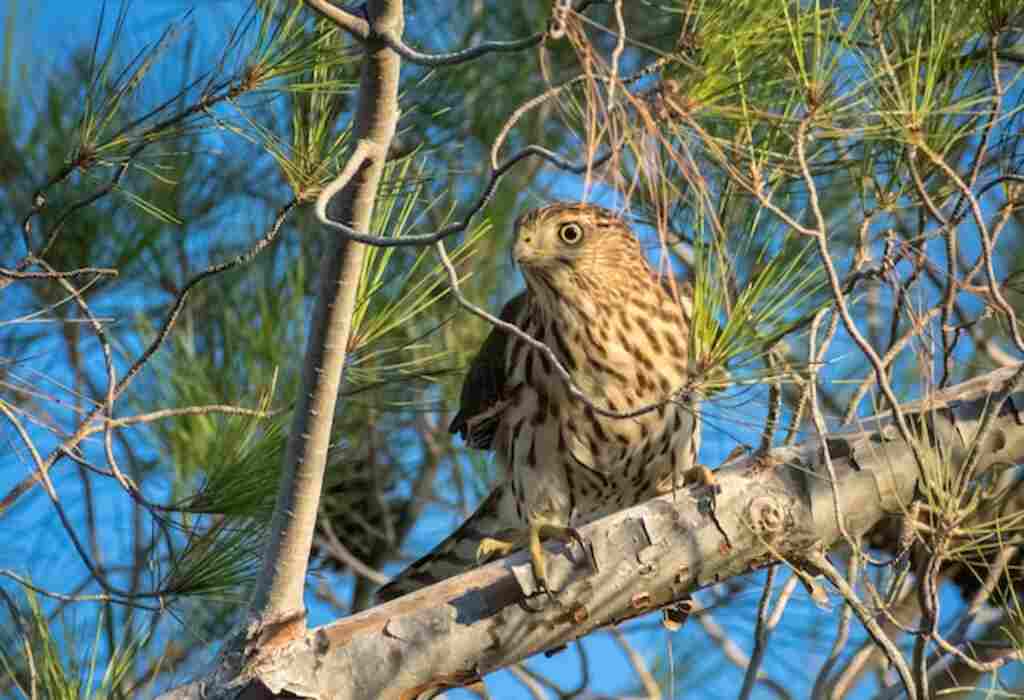The hawk, with its sharp talons, keen vision, and powerful wings, is a symbol of freedom and strength. It is a bird of prey that has captured the imagination of humans for centuries.
In Florida, hawks play an important role in the ecosystem, serving as top predators that keep populations of small animals in check.
But what do hawks eat in Florida?
To answer this question, we must delve into the fascinating world of these birds of prey.
From small mammals to fish, hawks have a diverse diet that varies depending on the species and the environment in which they live.
Understanding the food habits of hawks is not only essential for their survival but also for the well-being of the ecosystems they inhabit.
In this article, we will explore the different types of hawks found in Florida and their hunting techniques, as well as the role they play in the food web and the efforts being made to protect them.
Table of Contents
- 1 Key Takeaways
- 2 Overview of Hawks in Florida
- 3 Common Types of Hawks in Florida
- 4 What Do Hawks Eat In Florida?
- 5 Small Mammals
- 6 Reptiles and Amphibians
- 7 Insects and Arachnids
- 8 Other Birds
- 9 Fish and Crustaceans
- 10 Hunting Habits and Techniques
- 11 Role in the Ecosystem
- 12 Conservation and Protection
- 13 Frequently Asked Questions
- 14 Conclusion
- 15 Author
Key Takeaways
- Hawks in Florida have a diverse diet that varies depending on their species and environment, with up to 80% of their prey consisting of rodents and small animals.
- Hawks are skilled hunters with impressive accuracy and agility, using their sharp talons and beaks to capture and kill prey, and their unique physical characteristics and hunting strategies influence their prey selection and hunting behavior.
- Hawks play an important role in the food chain and help control the population of prey species, but their predatory behavior targeting small mammals can impact reptile and amphibian populations, and there is concern about their impact on urban bird populations.
- Conservation and protection efforts are essential for maintaining healthy ecosystems, and management strategies are in place to safeguard hawks from threats, such as habitat loss and climate change. The Florida Hawkwatch program monitors populations and guides conservation efforts, and citizen science initiatives encourage reporting of sightings to contribute to understanding of distribution and abundance.
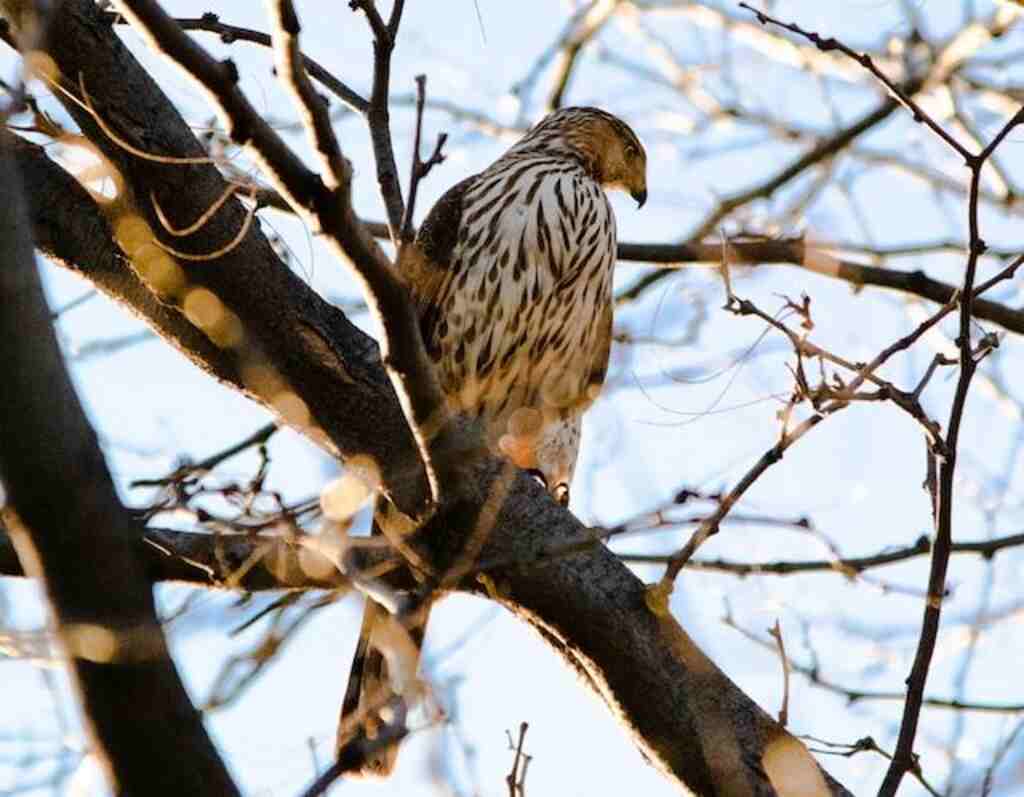
Overview of Hawks in Florida
The state of Florida is home to a diverse range of hawk species, including the red-shouldered hawk, Cooper’s hawk, sharp-shinned hawk, and red-tailed hawk, each with unique physical characteristics and hunting strategies.
The hawk population trends in Florida are influenced by factors such as habitat availability, prey population fluctuations, and climate change.
Some hawk species are year-round residents in Florida, while others migrate to and from the state during specific times of the year.
Understanding the migration patterns of hawks is crucial for conservation efforts and habitat management.
In the subsequent section, we will explore the common types of hawks in Florida and their preferred prey.
Common Types of Hawks in Florida
Several species of predatory birds can be found in the skies of Florida, including the Red-shouldered Hawk, Cooper’s Hawk, and the majestic Bald Eagle.
These birds have different habitat preferences and hunting behaviors that help them survive in the diverse ecosystems of Florida.
The Red-shouldered Hawk, for example, prefers to live in forested areas near water sources where it can hunt for amphibians, reptiles, and small mammals.
Cooper’s Hawks, on the other hand, are commonly found in suburban areas, where they can prey on birds and small mammals.
The Bald Eagle, the national bird and symbol of the United States, is a powerful hunter that feeds on fish, water birds, and small mammals.
These hawks are fascinating creatures that play an important role in Florida’s ecosystem, and understanding their behavior and diet is crucial for their conservation.
In the next section, we will explore the diet of small mammals that hawks in Florida feed on.
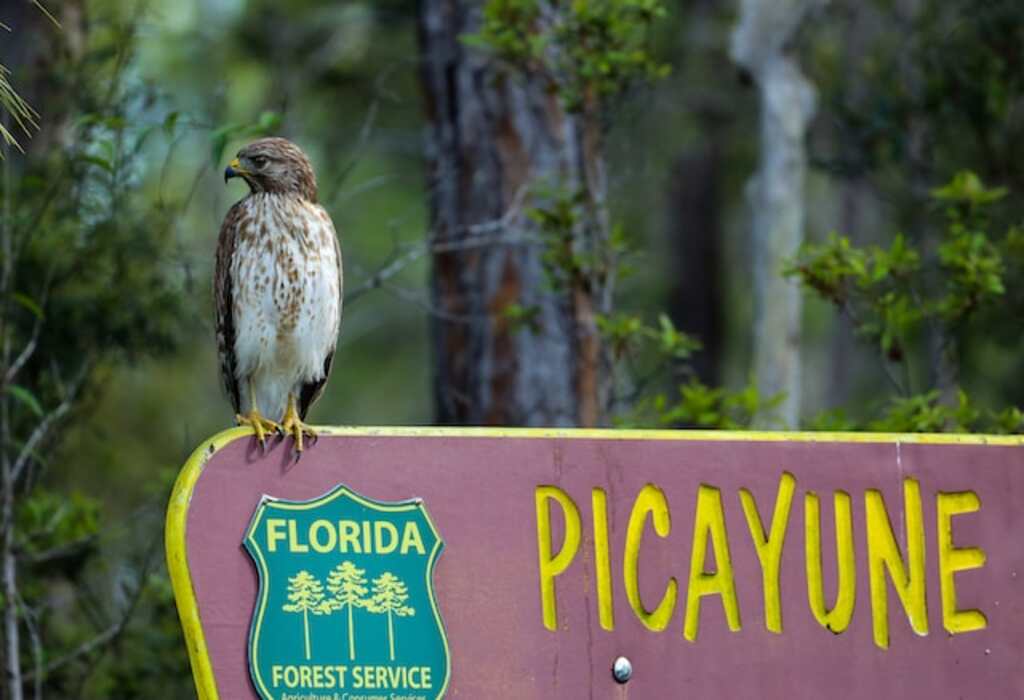
What Do Hawks Eat In Florida?
Hawks in Florida have a diverse diet that includes small mammals like rabbits, squirrels, and mice. They also prey on reptiles such as snakes and lizards, as well as amphibians like frogs.
Insects and arachnids, such as grasshoppers and spiders, are part of their diet too. Hawks also feed on other birds like pigeons and doves.
Additionally, fish and crustaceans contribute to their food sources. Hawks play an essential role in maintaining the ecosystem’s balance by controlling populations of their prey species.
Small Mammals
Different species of predatory birds found in Florida exhibit predatory behavior by targeting small mammals as part of their diet.
Studies have shown that up to 80% of their prey consists of rodents and other small animals.
Hawks, for instance, are known to prey on squirrels, rabbits, and mice. They have sharp talons and beaks that allow them to swiftly catch and kill their prey.
These birds exhibit prey selection, choosing their targets based on factors such as size, behavior, and location.
Furthermore, they have been observed to hunt during the day, usually in open spaces or near wooded areas.
Understanding their feeding habits and prey selection is crucial in maintaining a balanced ecosystem. Moving on to the next subtopic, reptiles and amphibians also make up a significant portion of their diet.
Reptiles and Amphibians
Reptiles and amphibians are a significant part of the diet of predatory birds found in Florida.
The predator-prey dynamics of these species are fascinating, as they have adapted to survive in this ecosystem.
Birds like hawks and eagles have a significant ecological impact on the population of these creatures.
They are known to hunt a variety of reptiles and amphibians, including snakes, lizards, frogs, and toads. The birds’ sharp talons and beaks are perfectly adapted to capture and kill these creatures.
Their feeding habits have a significant impact on the ecosystem, as they help control the population of these animals.
Despite their vital role in the food chain, the hunting habits of these birds can be a cause for concern for conservationists.
The next subtopic will delve into the diet of hawks and other predatory birds, focusing on insects and arachnids.
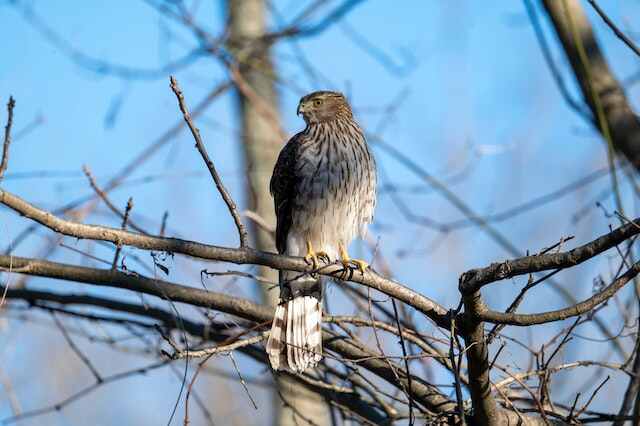
Insects and Arachnids
The Subtopic of Insects and Arachnids covers a broad range of creatures that hawks in Florida may prey upon.
Grasshoppers and crickets, for instance, are common prey items for many species of hawk.
Spiders and scorpions, although perhaps less frequently consumed, are also potential food sources for these birds of prey.
Grasshoppers and Crickets
Grasshoppers and crickets are a staple food source for hawks in Florida, with these insects being devoured by the birds with the same voracity as a child eating candy on Halloween.
These small creatures are not only easy prey for the hawks, but they also provide a high source of protein and other essential nutrients that are necessary for the birds to survive.
The predation behavior of hawks on grasshoppers and crickets has an ecological impact as well, as it helps to control the population of these insects in the ecosystem.
The hawks play an important role in maintaining the balance of the food chain, and their diet of grasshoppers and crickets is a crucial part of this.
As the hawks continue to hunt for these insects, they ensure that the ecosystem remains healthy and thriving.
Moving on to the next subtopic about spiders and scorpions, it is important to note that these creatures also play a significant role in the diet of hawks in Florida.
Spiders and Scorpions
Spiders and scorpions are also part of the diet of hawks in Florida, adding diversity to their prey selection. Hawks are natural predators of these arachnids and their venomous sting, which can cause paralysis or death to smaller animals.
These birds of prey have adapted to the challenges of hunting such prey, using their sharp talons and beaks to avoid getting stung or bitten.
However, not all spiders and scorpions are fair game for hawks, as some species have developed defenses against these predators.
For example, the bark scorpion, a common species in Florida, has a venom that is lethal to most animals, including birds.
To avoid this danger, hawks usually hunt younger or smaller scorpions that have not yet developed their full venom.
To evoke emotion in the audience, the following table shows the top 5 most venomous spiders and scorpions in Florida, along with the effects of their venom on humans and animals.
This information highlights the danger that hawks face when hunting such prey, and the risks that humans face when encountering these venomous arachnids.
Moving on to the next subtopic, hawks also feed on other birds that inhabit Florida’s diverse ecosystems.
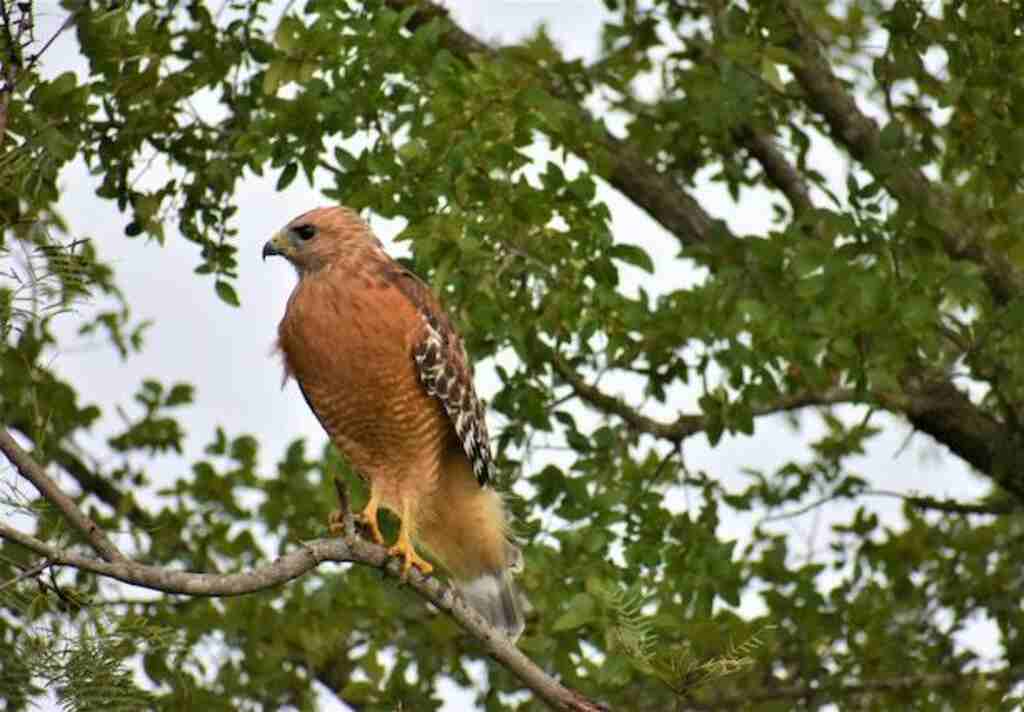
Other Birds
The Subtopic of Other Birds includes a diverse range of bird species such as Pigeons and Doves, Songbirds, and Finches.
Pigeons and Doves are classified as granivorous birds, meaning they primarily feed on seeds and grains.
Songbirds and Finches, on the other hand, have a varied diet that includes insects, fruits, and seeds.
Pigeons and Doves
Pigeons and doves are a common prey for hawks in Florida, with one study estimating that they make up nearly 50% of their diet.
Hawks are known to be versatile hunters, and their habitat preferences and hunting behavior may vary depending on the species.
Some hawks prefer to hunt in open areas, while others prefer to hunt in forests or near water sources.
Their impact on urban bird populations has been a concern for wildlife managers, and various management strategies have been implemented to mitigate this impact.
One such strategy involves the use of non-lethal deterrents to discourage hawks from preying on urban bird populations.
Despite these efforts, hawks continue to be a major predator of pigeons and doves in Florida.
In the next section, we will explore the diet of hawks in Florida further, focusing on their predation of songbirds and finches.
Songbirds and Finches
Songbirds and finches are common prey for hawks in various habitats, and their hunting behavior may vary depending on the species.
Hawks are known to target songbirds during migration periods when they are weakened and vulnerable, and also during nesting behaviors when they are busy building nests and caring for young.
Different species of hawks may also have dietary restrictions and preferences, which can impact their hunting behavior.
For example, some hawks may prefer to hunt larger birds, while others may focus on smaller species such as finches.
Additionally, hawks may alter their hunting patterns during seasonal changes, such as shifting their focus to different prey items when certain foods become scarce.
Despite the varying strategies and preferences, hawks remain skilled hunters and are able to catch their prey with impressive accuracy and agility.
Moving on to the next section, hawks also have a taste for fish and crustaceans.

Fish and Crustaceans
Fish and crustaceans, which are abundant in Florida’s waterways, are a primary source of food for hawks in the region.
These birds of prey have adapted to the coastal environment, where they can hunt for a variety of aquatic creatures.
Hawks have been observed feeding on fish such as mullet, catfish, and tilapia, as well as crustaceans like crabs and shrimp.
In recent years, shrimp farming has become a popular industry in Florida, but it has had a significant impact on coastal ecosystems.
The use of chemicals and antibiotics in shrimp farming has led to pollution and destruction of habitat for many aquatic animals, including the prey of hawks.
Despite these challenges, hawks have developed hunting techniques to survive in their changing environment.
They use their keen eyesight to spot prey from great distances, and their sharp talons to capture and kill their targets.
These impressive birds of prey have become a symbol of freedom and strength, inspiring awe and admiration in those who witness their hunting prowess.
Hunting Habits and Techniques
Hawks utilize their impressive hunting techniques and keen senses to capture prey in their coastal environment.
These birds of prey have specific hunting strategies and prey selection that are influenced by their adaptations and physical characteristics.
For instance, the sharp talons, powerful beak, and excellent eyesight enable hawks to swoop down and capture prey with ease.
Additionally, hawks are known to perch on high vantage points, such as trees or telephone poles, to survey their surroundings for potential prey.
Once they spot a suitable target, hawks will quickly dive and use their sharp talons to grab and immobilize their prey.
In Florida, hawks feed on a variety of prey, including small mammals, reptiles, birds, and insects.
Their ability to adapt to their surroundings and adjust their hunting techniques accordingly makes them a vital component of the ecosystem.
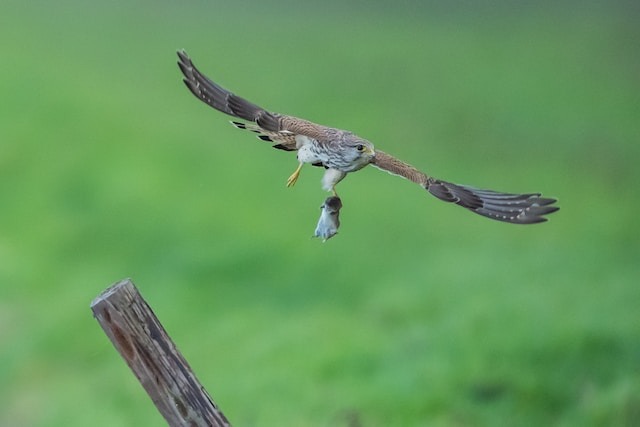
Role in the Ecosystem
As a top predator in the coastal ecosystem, the hawk’s role can be compared to that of a skilled hunter, maintaining balance and regulating populations of smaller prey species.
Hawks play an important role in the food chain, preying on rodents, reptiles, and other small animals.
They have a significant impact on the ecosystem, controlling the population of their prey species and preventing overgrazing and habitat destruction.
By keeping the balance between predator and prey in check, hawks help maintain healthy ecosystems that support a wide variety of species.
The importance of hawks in the ecosystem cannot be overstated, and their conservation and protection is crucial to the survival of many other species that depend on them.
Conservation and Protection
The conservation and protection of top predators like the hawk is essential for maintaining healthy and balanced ecosystems.
In Florida, management strategies are in place to safeguard these birds of prey from threats such as habitat loss, hunting, and poisoning.
The Florida Keys Hawkwatch program, for example, monitors hawk populations and provides valuable data to guide conservation efforts. Community involvement is also crucial in protecting hawks and their habitats.
Citizen science initiatives like the Audubon Christmas Bird Count and the Great Backyard Bird Count encourage people to report hawk sightings and contribute to the understanding of their distribution and abundance.
By working together, we can ensure that these majestic birds continue to thrive in Florida’s diverse ecosystems.
Frequently Asked Questions
What is the average lifespan of a hawk in Florida?
Have you ever wondered what factors affect the lifespan of hawks in Florida? Hawk behavior in mating season and environmental factors such as food availability and habitat quality are important determinants. Average lifespan ranges from 5-20 years.
How do hawks communicate with each other?
Hawks communicate with vocalizations and body language such as wing displays and postures. These signals convey territorial boundaries, courtship, and aggression. Their communication is a vital aspect of their social behavior and survival.
What are some common predators of hawks in Florida?
In Florida, the most common predator of hawks are great horned owls, followed by bald eagles and red-tailed hawks. Common prey for hawks in Florida include rodents, snakes, and other small birds.
How do hawks adapt to changes in their environment?
Hawks adapt to changes in their environment through various adaptation techniques such as changes in hunting strategies, migration, and changes in nesting patterns. These strategies ensure their survival and ability to thrive in different environments.
Can hawks be kept as pets?
Hawks are not recommended as pets due to legal restrictions and the difficulty of training them. Additionally, hawks are wild animals and require freedom to thrive in their natural environment.
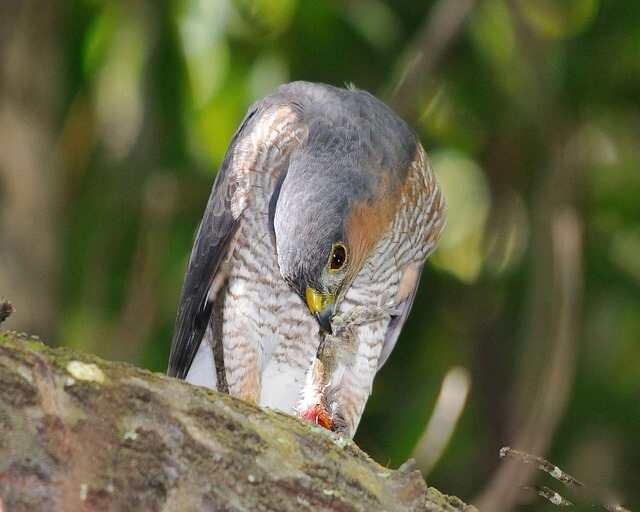
Conclusion
Hawks are a common sight in Florida’s skies and play a vital role in the ecosystem by controlling populations of small mammals, reptiles, amphibians, insects, and fish.
The most commonly found hawks in Florida are the red-shouldered hawk, the Cooper’s hawk, and the red-tailed hawk.
These birds of prey use a variety of hunting techniques, such as soaring in the sky, perching on trees, and using stealth and speed to capture their prey.
Small mammals, such as mice, rats, and squirrels, are a significant part of a hawk’s diet in Florida.
These birds also hunt for reptiles and amphibians, including snakes, lizards, and frogs. Insects and arachnids, such as grasshoppers, spiders, and beetles, are also part of their diet.
Hawks are also known to capture fish and crustaceans, such as crabs and crayfish, in shallow waters.
Despite their predatory nature, hawks are essential to maintaining the balance of the ecosystem in Florida.
They help prevent overpopulation of certain species and maintain the health of the environment.
It is crucial to protect and conserve these birds of prey and their habitats to ensure their survival for generations to come.
Anecdotes can be an effective way to evoke an emotional response in the audience and create a lasting impact.
One such story involves the red-shouldered hawk, which is known for its distinctive call that sounds like ‘kee-yer.’ This call is often heard in the swamps and marshes of Florida, where these hawks hunt for prey.
A few years ago, a group of birdwatchers witnessed a red-shouldered hawk diving into the water to capture a fish.
The bird was successful in its hunt and flew away with the fish in its talons.
This anecdote illustrates the resilience and adaptability of hawks, who are capable of hunting in various environments and using different techniques to capture their prey.
It also highlights the importance of protecting the natural habitats of these birds of prey, which are essential to their survival and the health of the ecosystem as a whole.

